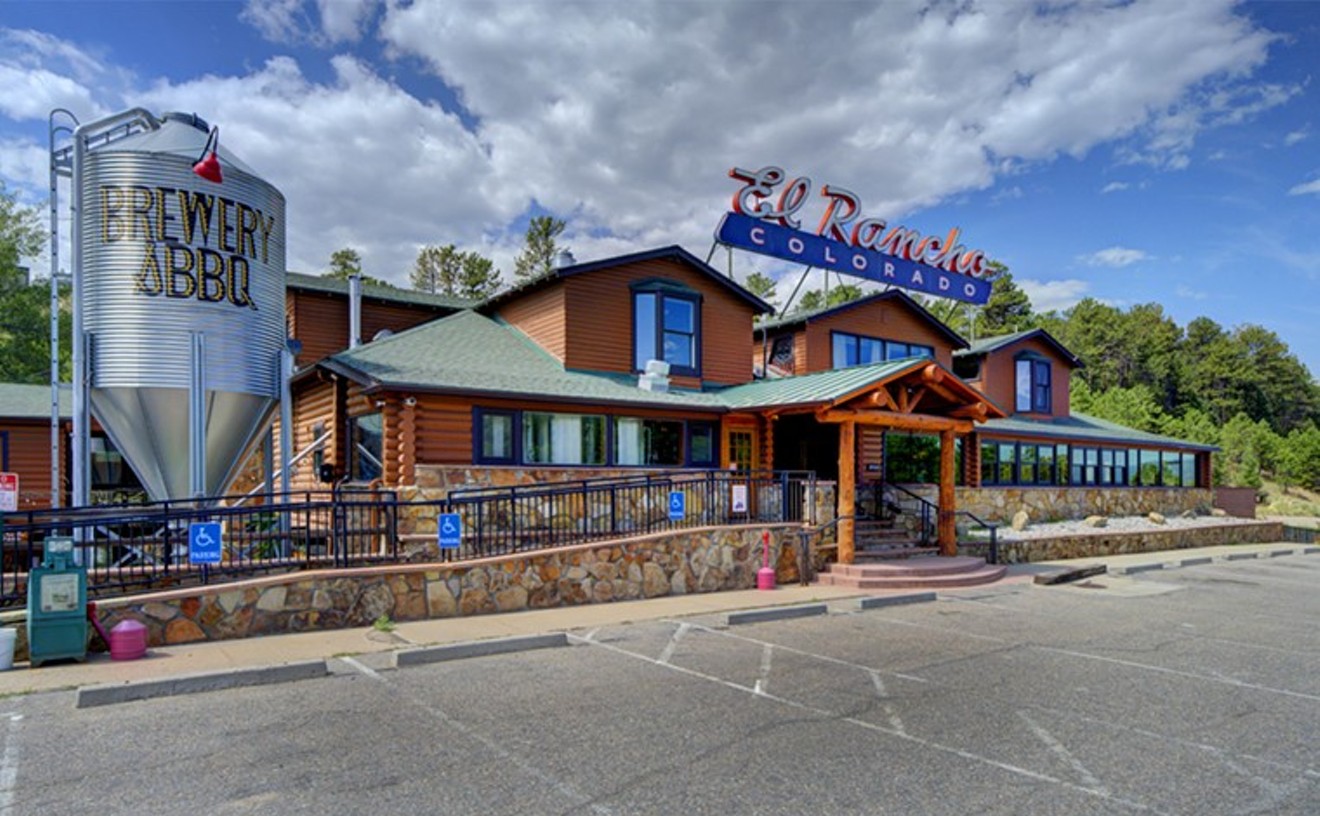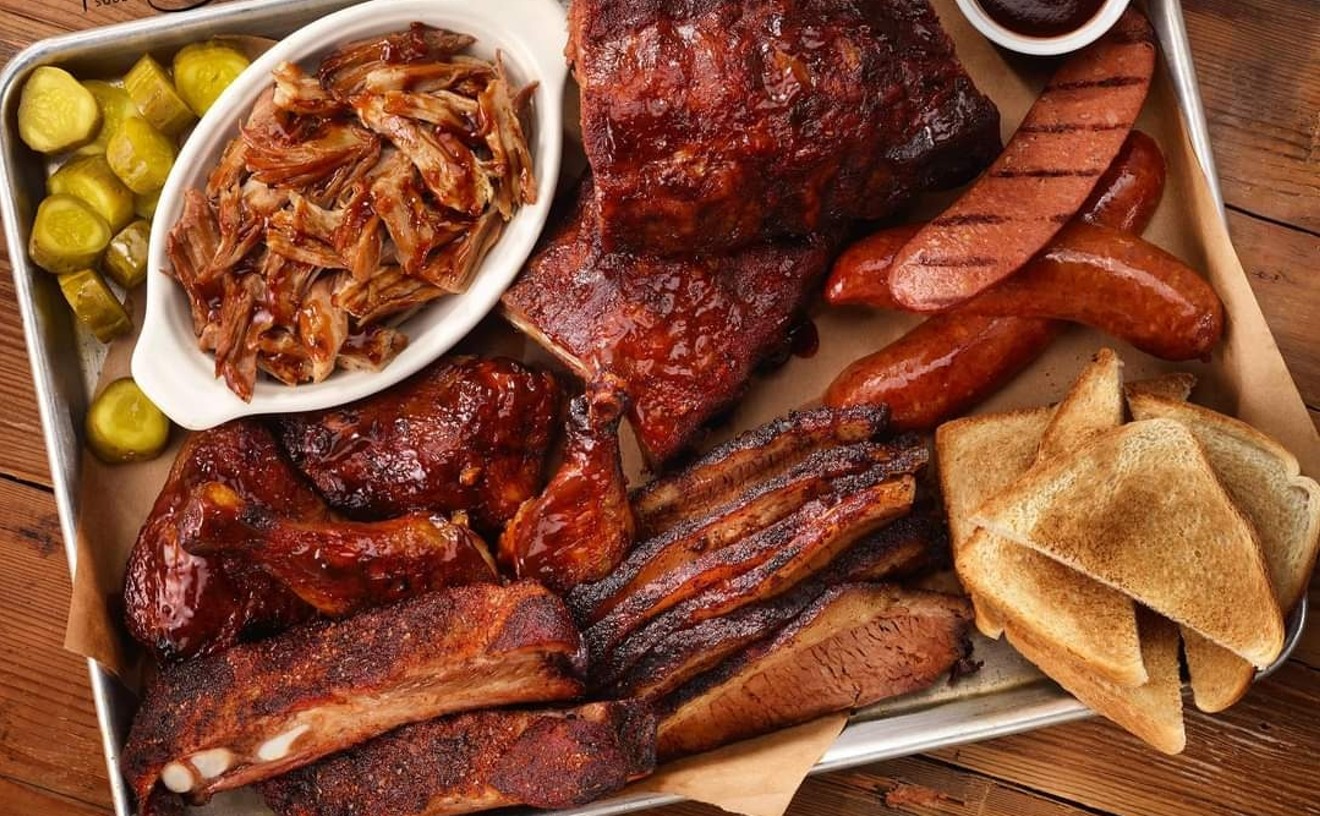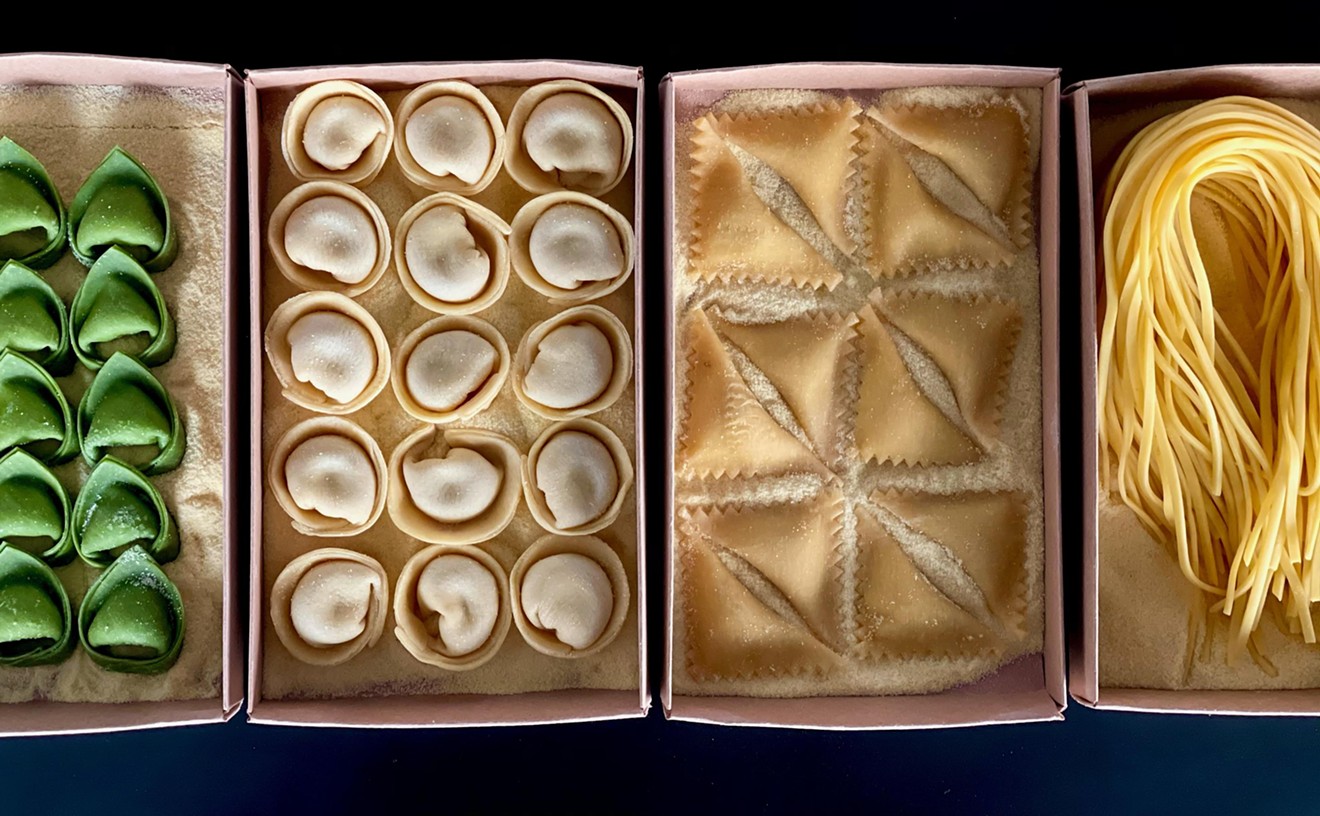"I have two specials to tell you about tonight," our waitress said, smiling, struggling to make eye contact as Barry -- my go-to steakhouse guy -- and I pored over the newsprint menu, looking for the biggest steaks available at the Buckhorn Exchange.
The first special was a fairly run-of-the-mill (for Colorado) game plate of buffalo steak and elk tenderloin. I get a giggle out of a restaurant founded 113 years ago by one of William Cody's original scouts being so proud of the buffalo steaks it now serves. You know why they called that guy Buffalo Bill? Because he killed so many of them. Because he was a big part of the near extinction of the American bison -- Cody claimed to have personally put down 4,280 head in one seventeen-month stretch with rifle, pistol, claw hammer, pointy stick, whatever -- and made a name for himself as a buffalo hunter back in the days when everything from hair tonic to underpants was made out of bison parts. It's like a restaurant founded by Charles Darwin's brother-in-law being overly proud of its Gal´pagos turtle soup.
But I perked up at her mention of the second special: a freaky intercontinental meat combo featuring whole quail, ostrich and yak. I looked up from the menu and asked the waitress to repeat herself to make sure I'd heard right, and I had. Quail in a prickly pear and apricot glaze, ostrich loin and yak steak.
"Seriously, yak?" I said.
She smiled wanly. "Yes, sir. It's very tasty. Is that what you'd like?"
But she already knew the answer. Maybe on another night, in different company, I would've gone for the yak (because if any guy in this town is going to get a little foodie hard-on over the opportunity to eat one of God's less conventionally palatable creatures, that guy is me), but right then, I had beef on my mind. Big beef. A really large, fatty, bloody beef steak made just for me (and Barry), so I gave her the same answer she'd been getting and would continue to get for the rest of the night: No, thanks. I think I'll just have the cow.
Like I said, no matter how good a server is, it's tough to move yak in a cow town like Denver.
She did talk us into an appetizer of buffalo tips in a glossy mushroom sauce, though. Originally (and no doubt under orders from management), she'd tried to sell us on the Buckhorn's rattlesnake app or the fried alligator (both easier to sell than yak meat, but not much), but we'd demurred because neither of us wanted snake and I'd had the Buckhorn's alligator before. It tasted like chicken. And good 'gator, properly prepared, shouldn't taste anything like chicken.
The buffalo was a nice compromise, a smallish dish filled with tender bits of meat in a sauce that was pleasant in a strip-mall, Italian-marsala kind of way -- all commercial beef base, sliced button mushrooms, shelf stabilizers and salt. It was a tease to the appetite, satisfying -- almost comforting -- in the way that old Levi's and "Black Dog" can be when blue jeans and classic rock are what you crave. But then, you don't step inside the Buckhorn expecting culinary innovation. Even the kitchen's most nouvelle tricks come from well-trod territory -- the snapper filets with fruit salsa an imprudent California retread, the lamb chops with red-currant Madeira sauce straight out of Fannie Farmer.
No, you come here for a big bite of Colorado history. The Buckhorn is full of it, right down to all the historical notes on the menu about original owner Henry H. Zeitz, who rode with Buffalo Bill for ten years before settling in Denver and opening his own watering hole, once shot a bandit in the back for hitting one of his waitresses, and in 1938 was presented with Custer's sword by a procession of thirty Indians riding down Osage Street, led by a nephew of Sitting Bull. And you come for the meat.
I have certain rules about steakhouses, some of which I've stumbled on accidentally, others of which I've acquired through long experience. The first is to never order anything with a nickname. If there's a cut of beef called "The Terminator," don't order it. Ditto "The Trailhand," "The Trucker-Choker," "Li'l Pardner" or any derivation thereof. And this goes double for any entree with a proper name attached, which is why I've never tried the Buckhorn's "Gramma Fanny's pot roast" and never will.
Second, beware of menus that come with translations. If a house has gone to the trouble of translating "Cornish game hen" or "Rocky Mountain oysters" into Spanish, French, German and Japanese, that means it sees plenty of tourists. And a menu written for tourists is often a menu designed and cooked for tourists -- with a deliberate "Flavor of Whereverville" vibe running through everything and flavors about as authentic as Doritos in a Mexican restaurant. On the night Barry and I came for dinner, the parking lot was full of grumpy Germans and the dining room with at least two big tables of out-of-town guests oohing and aahing over the decor, asking if the salmon was served with or without its eyeballs, and being smirkingly hosted by Denverites who knew enough to order the steaks and keep their mouths shut.
I also think it's a little cruel for a menu to offer word-for-word translations that make Rocky Mountain oysters sound like "oysters of the mountain," which does not adequately warn an outsider that he is about to put balls in his mouth. Really, the dish should be translated as "fried testicles with horseradish" or something similar. But if it were, I imagine that sales would drop off considerably. The dish would be tougher to sell than yak.
Third, the quality of the meal -- regardless of what is ordered -- will vary in inverse proportion to both the amount of stuff on the walls and the number of items on the menu. Like making fantastic barbecue, cooking a great steak is a calling, a passion that brooks no distraction. Worrying over the dispersion of novelty license plates or bucolic hunting scenes in the dining room, the color of the tablecloths or the quality of the vegetarian plate only removes focus from the sacred act of putting fire to meat. According to this theory, the best steakhouse in the world would be a plain white room with plain white tables like something out of Sleeper, serving only one cut of meat, probably a bone-in prime rib or a fat porterhouse. And the worst would be Outback Steakhouse. Everything else falls somewhere in between.
Every square inch of the Buckhorn is covered with something. Every nook and cranny is jammed with gewgaws and antique bric-a-brac, every shelf crowded with a century's worth of Old West knickknackery. Upstairs, the 150-year-old bar and attached Victorian parlor look like museum exhibits dedicated to shotguns, whiskey bottles and beer steins, and the downstairs dining rooms are a taxidermy zoo of delicious mammals all stuffed and mounted amid framed reviews, newspaper clippings and signed publicity photos of celebs from the '70s, when the Buckhorn was sold by the Zeitz family and resurrected in its current incarnation. But there's a codicil to my rule about clutter, which calls for reversing the formula when calculating all animals -- living or dead -- used as decoration, as well as any display of weapons that could have been used in the wanton slaughter of said tasty and/or ferocious critters. This exception is similar to my rating system for Mexican restaurants, which depends on how much bullfighting paraphernalia is exhibited (bonus points for any actual bulls' heads or ears) and for roadhouse diners, which relies on the number of outdated calendars on the walls. Dead animals and the proud display of shootin' irons generally denote a kitchen that's friendly to carnivores and understands that a cow (or an elk, or a buffalo, or a yak) is really just ribs, strips, T-bones, sirloins and a couple hundred cheeseburgers on four legs.
And this is where the Buckhorn truly makes its bones, because there are hundreds of dead animals -- including bulls and a two-headed calf -- mounted on the walls, shelves and display cases, along with enough guns to arm a full platoon of historical recreationists. And that's not even counting those that customers might be packing. The Buckhorn is probably the only place I've seen that could host an NRA board meeting and outgun the members two to one. If Charlton Heston were ever to set foot in this joint (as plenty of stars already have), he'd think he'd died and gone to six-shooter heaven.
One last rule: When you find yourself in a place so full of guns and critters and history and tourists and things named after people's grandmothers, order the house specialty. It doesn't matter what it is (unless it has a nickname, in which case, see rule one), just go for it. On the brick flank of the Buckhorn building facing the parking lot, there's a big sign that pronounces: "Steak Dinners Our Specialty." It looks like Zeitz himself might've painted it there, and it's not an idle boast. When a kitchen has been cooking steaks more or less continually for 113 years, it's learned a few things. And when that kitchen has a specialty called simply the "Big Steak" (more a descriptor than a nickname), you can trust that it's going to be good. And big.
Barry and I had come looking for a big steak, so the Big Steak is what we ordered -- two pounds of beef, cut from a New York strip loin, trimmed tight but not lean, and broiled like hell in a hot oven until the entire surface had first caramelized, then crusted up nice and woody. It came on a trencher and was carved tableside, having been properly and admirably rested first, because it barely bled a drop. And it was great -- bloody-rare and cool at its heart, with a nice mineral flavor, shading into deep brownish-black on the surface with the smell and taste and texture of a healthy char. There was an unfortunate strip of tough connective tissue running through the center of one side, but that was more a quirk of biology than the fault of the kitchen. After the best bites were in my belly, I cut around the tough part and gnawed at the fat.
Although the Big Steak was accompanied by sautéed mushrooms and onions and garlic-spiked maître d' butter, the kitchen was wise enough to put all of these on the side, because purists know that vegetables, cooked fungus and a prophylactic smear of curded milk fat do nothing but get in the way of the natural excellence of a good piece of beef. A salad and some garlic mashed potatoes came on the side, too. As far as I was concerned, they might as well have been garnish.
While the Big Steak didn't rank in my top five steaks of all time, it did rate the second strata -- which is really saying something, because I have eaten a lot of excellent steaks over the years. And Barry (who has eaten even more excellent steaks, and at better addresses) was equally pleased -- surprised, even, because he is hard to satisfy and would have gladly stalked, cursing and shouting, from the dining room had the kitchen offended him with a piece of beef of less than superior quality. The cursing and shouting are one of the reasons I like to bring Barry along on these outings. I don't get to tell people what I think of their food face to face. But Barry, he never stops.
And all of the people at the Buckhorn -- the staff of both floor and desk -- were wonderful, bending to our every whim and going out of their way to take care of us (our server even offered to have the chef hold a portion of yak meat for dinner the next night if I was interested). When I had gotten stuck in traffic, the hostess had held my reservation. When Barry was late, they'd seen me comfortably seated at the bar and supplied with enough booze to keep me occupied until his arrival. They answered all of my questions and Barry's demands during dinner, and when we both complimented the house on a sublimely, decadently wonderful slice of apple pie topped with ice cream and cinnamon rum sauce, our server seemed truly happy that we were so happy (yak or no yak) and beamed like the sun when she saw us -- finally -- sated, stuffed with beef and pie, and ready for the bill.










